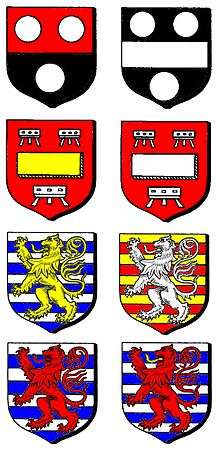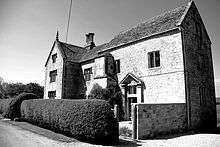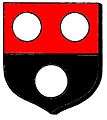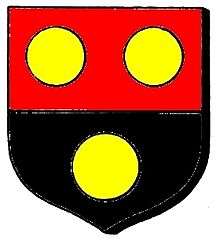Stratford family

- a) Per fess gules and sable, three plates
- b) Sable, a fess argent, between three plates
- c) Gules, a fess humette or, between three trestles, argent
- d) Gules, a fess humette between three trestles, argent
- e) Barruly of ten, argent and azure, a lion rampant, or
- f) Barruly of ten, or and gules, a lion rampant, argent
- g) Barruly of eight, argent and azure, a lion rampant, gules
- h) Barruly of ten, argent and azure, a lion rampant gules, langued or[1][2][3][4][5]

The Stratfords are an ancient family of England, either giving their name to, or taking it from, Stratford-on-Avon in the 12th century and traceable back to the Norman conquest. Their branches include the clergy, the gentry, and the aristocracy. Since their establishment the Stratfords have spawned numerous religious, cultural and political leaders, multiple Bishops, Archbishops, Viscountcies, Baronies and an Earldom.[6] Historic family seats have included Farmcote Manor and Stratford Park in Gloucester,[7] Merevale Hall in Warwickshire,[8] Baltinglass Castle,[9] Belan House and Aldborough House in Ireland, and Stratford House in London.[10] They have links with numerous noble families, including the Tracys, Sudeleys, Dugdale baronets, Throgmortons, Overburys, and Wingfields.[11][9] They were at their most powerful in the 14th and 18th centuries.
The Warwickshire Stratfords (13th-14th Century)
Robert de Stratford, an original burgess of Stratford-on-Avon, is the earliest indisputably traceable member of the paternal Stratford line. His children and nephews rose to positions of power and influence in the political and religious landscape of England in the 14th century, and originated all other branches of the family.[12][13]
- John de Stratford (c.1275 - 1348), Bishop of Winchester, Lord High Treasurer, Lord Chancellor, Archbishop of Canterbury
- Robert de Stratford (c.1292 – 9 April 1362), Chancellor of the Exchequer, Chancellor of the University of Oxford, Lord Chancellor, Archdeacon of Canterbury, Bishop of Chichester
- Henry de Stratford Greater Clerk of the Royal Chancery under Edward III
- Thomas de Stratford (died June 12, 1396) Senior Proctor of Oxford University, Archdeacon of Gloucester, Prior of Caldwell
- Ralph de Stratford (c. 1300-1354), also known as Ralph Hatton of Stratford, Bishop of London
- Andrew de Stratford (died 1399), Church clerk, knight and landowner
The Stratfords of Merevale (17th-18th Century)

The Manor of Merevale in north Warwickshire (including the original Merevale Hall and estate) was purchased in the mid 17th century by Edward Stratford (died 1665). [9] Having established himself, Edward settled the sum of £500 on his younger brother Robert in order to fund his starting a life in Ireland.[11] Robert settled at Baltinglass Castle and went on to sire the Earls of Aldborough, and a close relationship between the Merevale and the Irish branch was maintained until the extinction.[14]
In 1749 the property was inherited by Penelope Bate Stratford (the daughter and co-heiress of Francis Stratford of Merevale) who married into the (now) Dugdale baronets, who still possess the estate.[9]
The Stratford Dugdales & Dugdale Baronets
In 1749 Merevale Hall was inherited by Edward's eventual descendant Penelope Bate Stratford (the daughter and co-heiress of Francis Stratford of Merevale) who married William Geast. William Geast took the surname of his Uncle, John Dugdale, and their child was Dugdale Stratford Dugdale who married the honourable Charlotte Curzon, daughter of Assheton Curzon, 1st Viscount Curzon of the (now) Earls Howe.[15] Their son William Stratford Dugdale had a son also named William Stratford Dugdale who had a son named William Francis Stratford Dugdale, who came to be the 1st Baronet.[16] The Merevale estate has descended to the present incumbent, his grandson Sir William Matthew Stratford Dugdale, 3rd Bt of the Dugdale baronets.[9]
- Sir William Francis Stratford Dugdale, 1st Baronet (1872-1965)
- Sir William Stratford Dugdale, 2nd Baronet (1922-2014)
- Sir William Matthew Stratford Dugdale, 3rd Baronet, born 22 Feb 1959; the only male issue of the 2nd Baronet's first marriage
- Thomas Joshua Stratford Dugdale FRSA (born 1974), British documentary film-maker, male issue of the 2nd Baronet's second marriage
The Gloucestershire Stratfords

It was Thomas de Stratford of the original Warwickshire Stratfords who first moved the family's interests to Gloucestershire, holding the post of Archdeacon of Gloucester. Stephen de Stratford, Kinsman to Thomas and John, was the father of another John Stratford who, in 1320, became a member of parliament for Gloucestershire, where the Stratfords had been granted Lordship of the Manor of Farmcote, Hawling and Temple Guiting in 1314. His son was raised to the knighthood as Sir Stephen Stratford,[17] and this branch of the family became resident at the ancient, feudal Farmcote Manor House following the dissolution of Hailes Abbey in 1539. This branch were cousins to Robert Dover, and involved in the establishment of the Cotswold Olimpick Games in 1612.[9]
The Farmcote and Hawling estates were sold in 1756, by sons of Walter Stratford, though part of Farmcote Manor still stands, and Stratford tombs, arms and effigies can be found in the estate chapel there.[9]
Notable members of this line include:
- John Stratford, member of parliament for Gloucestershire, 1320
- Sir Stephen Stratford, knight of the realm
- John Stratford (c.1582-c.1634) Merchant and entrepreneur, a significant grower of tobacco in the Cotswolds
The Irish Stratfords & Earls of Aldborough (18th-19th Century)

.jpeg)
A later branch of the family extended from the Stratfords of Merevale and into Ireland, where they went on to enter the peerage as Earls of Aldborough, of the Palatinate of Upper Ormond. The title was created on 9 February 1777, along with the subsidiary title Viscount Amiens, for John Stratford, 1st Viscount Aldborough.[18] He had already been created Baron Baltinglass, of Baltinglass, in the County of Wicklow,[19] on 21 May 1763, and Viscount Aldborough, of the Palatinate of Upper Ormond,[20] on 22 July 1776. These titles were also in the Peerage of Ireland. Three of his sons, the second, third and fourth Earls, all succeeded in the titles. They became extinct on the death of the latter's grandson, the sixth Earl, in 1875. Their seats were Belan House, Aldborough House, Baltinglass Castle and Stratford House.
- Robert Stratford (of the Merevale Stratfords)
- Edward Stratford, supporter of William of Orange[21] (who refused a peerage offered by William III) [22]
- John Stratford, 1st Earl of Aldborough (c. 1691–1777)
- Edward Stratford, 2nd Earl of Aldborough (d. 1801)
- John Stratford, 3rd Earl of Aldborough (c. 1740–1823)
- Benjamin O'Neale Stratford, 4th Earl of Aldborough (d. 1833)
- Mason Gerard Stratford, 5th Earl of Aldborough (1784–1849) (Bigamist)[23]
- Captain Benjamin O'Neale Stratford, 6th Earl of Aldborough (1808–1875)
The Stratford Cannings & Viscount Stratford de Redcliffe
Abigail Stratford was the daughter of Robert Stratford, progenitor of the Irish Stratfords. In 1697 she married George Canning,[24] and in 1703 they had a son, named Stratford Canning. He had a son sometime after 1734, also named Stratford Canning, who had a son in 1786, also named Stratford Canning, who was created 1st Viscount Stratford de Redcliffe on 24 April 1852.[25]
- Stratford Canning, 1st Viscount Stratford de Redcliffe KG GCB PC (1786–1880), a diplomat and politician, best known as the longtime British Ambassador to the Ottoman Empire
The Wingfield-Stratfords, Viscount Powerscourt, & Baron Wrottesley
Lady Amelia Stratford was the daughter of John Stratford, 1st Earl of Aldborough. On the 7th September 1760 she married Richard Wingfield, 3rd Viscount Powerscourt, and took his name; it is from this maternal Stratford lineage that the current Viscount Powerscourt descends.[26]
The Stratford descendant Viscounts Powerscourt are as follows:
- Richard Wingfield, 4th Viscount Powerscourt (1762–1809)
- Richard Wingfield, 5th Viscount Powerscourt (1790–1823)
- Richard Wingfield, 6th Viscount Powerscourt (1815–1844)
- Mervyn Wingfield, 7th Viscount Powerscourt (1836–1904)
- Mervyn Richard Wingfield, 8th Viscount Powerscourt (1880–1947)
- Mervyn Patrick Wingfield, 9th Viscount Powerscourt (1905–1973)
- Mervyn Niall Wingfield, 10th Viscount Powerscourt (born 1935)
- The heir apparent is the present holder's only son Hon. Mervyn Anthony Wingfield (born 1963).
When Edward Stratford, 2nd Earl of Aldborough (Amelia's brother) died in 1801 he bequeathed the bulk of his estate to Amelia's grandson (his nephew, too junior to inherit the Powerscourt Viscountcy) on the proviso that he took back the Stratford name, thus becoming John Wingfield-Stratford in 1802.[9] This line inherited Stratford House in London, and Amelia lived there until her death in 1831. It was sold in 1832.[10]
Notable Wingfield-Stratfords include:
- Brigadier-General Cecil Wingfield-Stratford CB, CMG (1853–1939) a British Army officer in the Royal Engineers and an English international footballer
- Captain Esmé Cecil Wingfield-Stratford DSC (1882–1971) an English historian, writer, mind-trainer, outdoorsman, patriot and ruralist
Esmé Cecil's daughter (Roshnara) married Richard John Wrottesley, 5th Baron Wrottesley, and though they later divorced it was through issue of their marriage that the Barony descended:
- Clifton Hugh Lancelot de Verdon Wrottesley, 6th Baron Wrottesley (b. 1968), great-grandson of Esmé Cecil Wingfield-Stratford[27]
- The heir apparent is the present holder's eldest son the Hon. Victor Wrottesley (born 2004)
Stratford Coats of Arms
There are two main variant coats of arms associated with the Stratford family, Type A (or "trinity") and Type B (or "lion"). Type A can be further divided into the "Trestle" and "Roundel" subtypes.[28]
Type A (trinity)
The Type A (or "trinity") Stratford Coat of Arms is the oldest of the two, first associated with John de Stratford and his familia in the early 1300s. It can be divided into two broad subtypes; Trestle, and Roundel.[29]
Trestle
-

Gules, a fess humette between three trestles, or
-

Gules, a fess humette or, between three trestles, argent
-

Gules, a fess humette or, between two trestles, argent
-

Gules, a fess humette between three trestles, argent
The Trestle type is most closely associated with the original Warwickshire Bishops, the Hampshire Stratfords descended from Andrew Stratford, and with Nicholas Stratford. The design is consistently based around gules, a fess humette, surrounded by three trestles argent (sometimes or). Variants include colour of fess and trestles, and number of trestles.[30]
In heraldry the trestle (also tressle, tressel and threstle) as a charge is extremely rare, and known for symbolising hospitality (as historically the trestle was a tripod used both as a stool and a table support). The fess humette is apparently intended to represent a banqueting table, with the trestles gathered around[31]
Roundel
-

Or, a fess gules, between three torteaux
-

Argent, a fess gules, between three bezants
-

Irish
Argent, a fess between three hawks heads erased, gules -

Gules, a fess argent, between three plates
-

Sable, a fess argent, between three plates
-

Per fess gules and sable, three plates
The Roundel type is associated solely with the medieval Bishops, and appears to be an archaic, simplified or corrupted version of the Trestle type. The design is consistently based around a fess, surrounded by three roundels. Variants include colour of fess, field and rondel.[32]
A single example of a variant Roundel type surviving is in the later Irish recording of a shield in the name of Stratford: argent, a fess between three hawks heads erased, gules.[33]
Streatfield
-

Stratford
Per fess gules and sable, three plates -

Streatfield
Per fess gules and sable, three bezants
The arms of the Streatfield (or Streatfeild) family, recorded in the 16th century, bear a striking resemblance to an attributed form of Stratford arms. This could be seen as evidence that the Streatfields, though their line cannot be traced beyond the 1500s, are in fact a branch of the Stratford family, the name having been corrupted at some point prior to the 16th century.[34]
Type B (lion)
-

Barruly of eight, argent and azure, a lion rampant gules
-

Paly of eight, argent and azure, a lion rampant gules
-

Barruly of five, azure and argent, a lion rampant ruby
-

Barruly of ten, argent and azure, a lion rampant gules, langued or
-

Barruly of ten, argent and azure, a lion rampant, or
-

Barruly of ten, or and gules, a lion rampant, argent
The Type B Stratford Coat of Arms was first recorded by the Heralds Visitations to Gloucester of 1543, and since has been consistently based around a lion rampant, gules, on a barruly of ten, Argent and Azure. It is associated with the Gloucester, Merevale and Irish branches. Variations have included the addition of a crescent to denote a younger son, a change in the barruly number, change in langue colour, and in lion colour.[35]
The Earls of Aldborough took supporters of human figures, a winged woman and armoured man, representing Fame and War. Officially: Dexter a Female figure, representing Fame, vested Ar, winged Or, in her right hand a trumpet gold, and in her left hand an olive branch vert, the sword belt Gules. Sinister, a man in complete armour Proper, garnished Or, spurs, sword, shield and spear of the last, sword belt Gules, holding in his right hand the spear, and upon his left arm the shield.
They also adopted the motto "Virtuti Nihil Obstat Et Armis" (Nothing Resists Valour and Arms).[35]
Luxembourg and Lusignan
-
.svg.png)
The Lusignan Coat of Arms, granted 12th Century
-

The Luxembourg Coat of Arms between 1282 and 1288 (Henry VI)
-

The Luxembourg Coat of Arms after 1288
-

The Stratford Type B Coat of Arms, first recorded 1543
-
.jpeg)
The Aldborough Arms, with Supporters (18th Century)
The Stratford Type B Coat of Arms is remarkably similar to two other prominent Coats of Arms, an extremely unorthodox occurrence. The exact relationship to the arms of Luxembourg and of Lusignan are unknown, if indeed any exists at all. Both bear (with some variation in number) a barruly of ten Argent and Azure, and both have a lion rampant gules - though often on these royal arms it is granted a crown (or), and the lion of Luxembourg bears a forked tail as difference. The similarity is too close to be dismissed satisfactorily as independent coincidence, and historians have generated various theories as to the connection between the houses and the arms, none conclusive.[36]
References
- ↑ Guillim, John. "A Display of Heraldry" 1724
- ↑ Bedford, WK Riland. "The Blazon of Episcopacy" 1858
- ↑ Papworth, John W. & Morant, Alfred. "Ordinary of British Armorials" 1874
- ↑ Burke, John. "General Armoury of England, Ireland and Scotland" 1847
- ↑ Berry, William. "Encyclopaedia Heraldica" 1828
- ↑ Stratford, Gerald "A History of the Stratford Family" Chapter 4. The Pedigree and Who Married Whom.
- ↑ Stratford, Gerald "A History of the Stratford Family" Chapter 6. Farmcote, The House, Manor, and Chapel.
- ↑ A History of the County of Warwick - Volume 4 (1947) pp142-147 from British History Online
- 1 2 3 4 5 6 7 8 Stratford, Gerald "A History of the Stratford Family" Chapter 11. The Extinct Earldom.
- 1 2 Stratford, Gerald "A History of the Stratford Family" Chapter 13. Belan, Aldborough, and Stratford House.
- 1 2 Stratford, Gerald "A History of the Stratford Family" Chapter 5. The Tracys, Dugdales, Throgmortons and Overburys.
- ↑ Blomefield and Parkin An essay towards a topographical history of the county of Norfolk pp. 390
- ↑ David Charles Douglas, Alec Reginald Myers "English historical documents. 4. [Late medieval]. 1327 - 1485" p. 69
- ↑ Cradock, Joseph "Literary and miscellaneous memoirs, Volume 1" pp. 23-24
- ↑ The Peerage entry for Dugdale Stratford Dugdale
- ↑ The Peerage entry for William Stratford Dugdale
- ↑ Thomas Dudley Fosbroke, "Companion to the Wye tour. Ariconensia; or, Archæological sketches of Ross and Archenfield: illustrative of the campaigns of Caractacus; the station Ariconium, &c., with other matters" pp. 165-166
- ↑ The London Gazette: no. 11739. p. 1. 25 January 1777. Retrieved 8 May 2009.
- ↑ The London Gazette: no. 10311. p. 1. 7 May 1763. Retrieved 8 May 2009.
- ↑ The London Gazette: no. 11679. p. 1. 29 June 1776. Retrieved 8 May 2009.
- ↑ J. Nichols "A biographical peerage of Ireland, in which are memoirs and characters of the most celebrated persons of each family" pp. 107-108
- ↑ The Peerage entry for Edward Stratford
- ↑ G.E. Cokayne; with Vicary Gibbs, H.A. Doubleday, Geoffrey H. White, Duncan Warrand and Lord Howard de Walden, editors, The Complete Peerage of England, Scotland, Ireland, Great Britain and the United Kingdom, Extant, Extinct or Dormant, new ed., 13 volumes in 14 (1910-1959; reprint in 6 volumes, Gloucester, U.K.: Alan Sutton Publishing, 2000), volume I, page 100. Hereinafter cited as The Complete Peerage.
- ↑ The Peerage entry for Abigail Stratford
- ↑ The Peerage entry for Stratford Canning, 1st Viscount Stratford de Redcliffe
- ↑ The Peerage entry for Lady Amelia Stratford
- ↑ "The Peerage" entry for Roshnara Barbara Wingfield-Stratford
- ↑ Burke, John. "General Armoury of England, Ireland and Scotland" 1847
- ↑ Bedford, WK Riland. "The Blazon of Episcopacy" 1858
- ↑ Bedford, WK Riland. "The Blazon of Episcopacy" 1858
- ↑ Guillim, John. "A Display of Heraldry" 1724
- ↑ Bedford, WK Riland. "The Blazon of Episcopacy" 1858
- ↑ Papworth, John W. & Morant, Alfred. "Ordinary of British Armorials" 1874
- ↑ Guillim, John. "A Display of Heraldry" 1724
- 1 2 Stratford, Gerald "A History of the Stratford Family" Chapter 2. The Stratford Family Heraldry
- ↑ Péporté, Pit. "Constructing the Middle Ages: Historiography, Collective Memory and Nation-Building in Luxembourg" pp 80-93. BRILL. (2011)
Further reading
- Haines, Roy Martin. Archbishop John Stratford, Political Revolutionary and Champion of the Liberties of the English Church, ca.1275/80-1348. Toronto: Pontifical Institute of Mediaeval Studies. ISBN 0888440766. (1986, biography)
- Haines, Roy Martin. "Bishop John Stratford's Injunctions to his Cathedral Chapter and to other Benedictine Houses in Winchester", Revue bénédictine, t. 117 (2007), 154–80
- Haines, R.M. (ed.). The Register of John de Stratford, Bishop of Winchester, 1323-1333: Vol. I. Surrey Record Society. 42. Woking. ISBN 9780902978171. (2010, historical records)
- Haines, R.M. (ed.). The Register of John de Stratford, Bishop of Winchester, 1323-1333: Vol. II. Surrey Record Society. 43. Woking. ISBN 9780902978188. (2011, historical records)
- Ethel M Richardson. "Long Forgotten Days Leading to Waterloo" Heath, Cranton limited (1928)
- Ronald W. Lightbown, "An Architect Earl: Edward Augustus Stratford (1736-1801), 2nd Earl of Aldborough" OLL Editions in association with the Irish Georgian Society (2009)
- Ada K. Longfield (Mrs. H. G. Leask), Linen and Cotton Printing at Stratford-on-Slaney, County Wicklow The Journal of the Royal Society of Antiquaries of Ireland, Vol. 75, No. 1 (Mar., 1945), pp. 24–31 (1945, regarding Edward Stratford, 2nd Earl of Aldborough, and his work in founding Stratford-on-Slaney)
- Martina Galvin, "Interior Landscapes: Aldborough House" Blurb Self-Publishing (2011, Photobook)
- Stanley Lane-Pool, The life of Stratford Canning, Viscount Stratford de Redcliffe, from his memoirs and private and official papers (1888, biography)
- E. C. Wingfield-Stratford, Before the lamps went out (1946, autobiography)
External links
- The Stratford Family by Gerald Stratford (A partial history of the family written in 1988)
- Genealogy forum for the surname: Stratford
- Stratford DNA Project (a genetic genealogy project for the surnames Stratford, Stafford, Spafford, Staford, Stowford, Strafford, and Styweard)